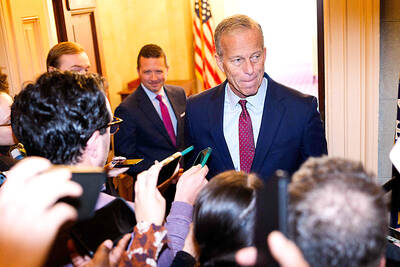A pro-China network of fake and impostor accounts found a global audience on YouTube, Facebook and Twitter to mock the US response to the COVID-19 pandemic as well as a deadly riot in Washington that left five dead, research published on Thursday found.
Messages posted by the network, which also praised China, reached the social media feeds of government officials, including some in China and Venezuela who retweeted posts from the fake accounts to millions of their followers.
The international reach marked new territory for a pro-China social media network that has been operating for years, said Ben Nimmo, head of investigations at Graphika, the social media analysis firm that monitored the activity.
“For the very first time, it started to get a little bit of audience interaction,” Nimmo said.
The network’s messaging aligns closely with posts and comments made by Chinese government officials.
However, it is unclear who is behind the fake accounts, which posted more than 1,400 videos in English, Mandarin and Cantonese, Nimmo said.
One of the Twitter accounts, which had a following of about 2,000 users mostly from Latin America, also tweeted the messaging in Spanish.
The posts appear to target social media users outside of the US, gaining traction in Taiwan, Hong Kong and Venezuela — where Chinese and US interests have increasingly come into conflict.
“The overall message is: America is doing very badly. China is doing very well,” Nimmo said. “Who do you want to be like?”
The network used photos of Chinese celebrities on the accounts and, in one case, hijacked the verified Twitter account of a Latin American soap opera show to post messages, the Graphika report showed.
The accounts seized on the Jan. 6 insurrection in Washington as the US Congress met to certify the US election results at the US Capitol.
One video described the US as a “failed state” and another said that it was “running naked in front of the world” in the wake of the Capitol siege.
Three videos described the riot as a “beautiful sight to behold,” mimicking the language used in Chinese state media reports on the riot, the report found.
Relations between Washington and Beijing worsened under former US president Donald Trump, who launched an aggressive diplomatic and economic offensive against China.
That tension has played out on social media, where Chinese officials in the past few years aired pointed criticisms of Trump.
Chinese Ministry of Foreign Affairs spokesman Zhao Lijian (趙立堅) has been one of the most vocal critics of the US on social media, spreading a conspiracy theory on Twitter last year that COVID-19 began in the US, despite evidence that the virus originated in the Chinese city of Wuhan.
However, even after Trump’s exit from office on Jan. 20, the network has continued to push anti-US posts.
Some of the accounts have now pivoted to attacking the Democratic Party by accusing leaders of having a “one-party mentality” in videos posted to YouTube, the report found.
Other fake accounts have questioned the safety of US-approved COVID-19 vaccines, despite studies on tens of thousands of people that found no serious side effects.
“The safety of the ... vaccine was in doubt, but it was quickly approved,” one of the pro-China videos posted on Jan. 21 claimed in a headline.
Other posts praised China’s response to the pandemic, while criticizing the US’ ability to contain the virus.
“There’s this cherry-picking of narratives and events that make the US look really bad,” Nimmo said.
Last month, YouTube said that it in December last year removed more than 3,000 YouTube channels that were identified as part of Graphika’s investigation into influence campaigns linked to China.

James Watson — the Nobel laureate co-credited with the pivotal discovery of DNA’s double-helix structure, but whose career was later tainted by his repeated racist remarks — has died, his former lab said on Friday. He was 97. The eminent biologist died on Thursday in hospice care on Long Island in New York, announced the Cold Spring Harbor Laboratory, where he was based for much of his career. Watson became among the 20th century’s most storied scientists for his 1953 breakthrough discovery of the double helix with researcher partner Francis Crick. Along with Crick and Maurice Wilkins, he shared the

China’s Shenzhou-20 crewed spacecraft has delayed its return mission to Earth after the vessel was possibly hit by tiny bits of space debris, the country’s human spaceflight agency said yesterday, an unusual situation that could disrupt the operation of the country’s space station Tiangong. An impact analysis and risk assessment are underway, the China Manned Space Agency (CMSA) said in a statement, without providing a new schedule for the return mission, which was originally set to land in northern China yesterday. The delay highlights the danger to space travel posed by increasing amounts of debris, such as discarded launch vehicles or vessel

IMPASSE: US President Donald Trump pressed to end the filibuster in a sign that he is unlikely to compromise despite Democrat offers for a delayed healthcare vote The US government shutdown stretched into its 40th day yesterday even as senators stayed in Washington for a grueling weekend session hoping to find an end to the funding fight that has disrupted flights nationwide, threatened food assistance for millions of Americans and left federal workers without pay. The US Senate has so far shown few signs of progress over a weekend that could be crucial for the shutdown fight. Republican leaders are hoping to hold votes on a new package of bills that would reopen the government into January while also approving full-year funding for several parts of government, but

TOWERING FIGURE: To Republicans she was emblematic of the excesses of the liberal elite, but lawmakers admired her ability to corral her caucus through difficult votes Nancy Pelosi, a towering figure in US politics, a leading foe of US President Donald Trump and the first woman to serve as US House of Representatives speaker, on Thursday announced that she would step down at the next election. Admired as a master strategist with a no-nonsense leadership style that delivered for her party, the 85-year-old Democrat shepherded historic legislation through the US Congress as she navigated a bitter partisan divide. In later years, she was a fierce adversary of Trump, twice leading his impeachment and stunning Washington in 2020 when she ripped up a copy of his speech to the